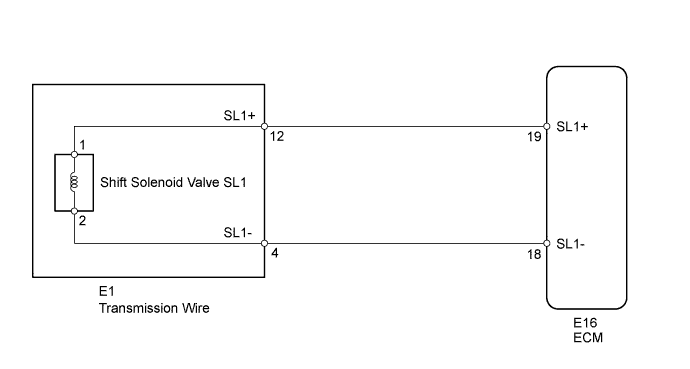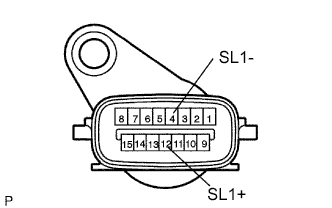Dtc P0748 Pressure Control Solenoid A Electrical (Shift Solenoid Valve Sl1)
DESCRIPTION
MONITOR DESCRIPTION
WIRING DIAGRAM
INSPECTION PROCEDURE
INSPECT TRANSMISSION WIRE (SHIFT SOLENOID VALVE SL1)
CHECK WIRE HARNESS (TRANSMISSION WIRE - ECM)
INSPECT SHIFT SOLENOID VALVE SL1
DTC P0748 Pressure Control Solenoid "A" Electrical (Shift Solenoid Valve SL1) |
DESCRIPTION
Shifting from 1st to 5th is performed in combination with the ON and OFF operation of the shift solenoid valves SL1, SL2, S1, S2 and SR, which are controlled by the ECM. If an open or short circuit occurs in the shift solenoid valves, the ECM controls the remaining normal shift solenoid valve to allow the vehicle to be operated safely (Toyota Fortuner RM000000O8L0B4X.html).DTC Code
| DTC Detection Condition
| Trouble Area
|
P0748
| ECM checks for an open or short in shift solenoid valve SL1 circuit while driving and shifting between 4th and 5th gear (1 trip detection logic)
Output signal duty equal to 100%
- HINT:
- SL1 output signal duty is less than 100% under normal condition
| - Open or short in shift solenoid valve SL1 circuit
- Shift solenoid valve SL1
- ECM
|
MONITOR DESCRIPTION
This DTC indicates an open or short in the shift solenoid valve SL1 circuit. The ECM commands gear shifts by turning the shift solenoid valves ON/OFF. When there is an open or short circuit in any shift solenoid valve circuit, the ECM detects the problem, illuminates the MIL and stores the DTC. Also, the ECM performs the fail-safe function and turns the other normal shift solenoid valves ON/OFF. In case of an open or short circuit, the ECM stops sending the current to the open or short circuited solenoid.While driving and shifting between 4th and 5th gears, if the ECM detects an open or short in the shift solenoid valve SL1 circuit, the ECM determines that there is a malfunction (Toyota Fortuner RM000000O8L0B4X.html).
WIRING DIAGRAM
INSPECTION PROCEDURE
- HINT:
- The shift solenoid valve SL1 turns ON/OFF normally when the shift lever is on D:
ECM gear shift command
| 1st
| 2nd
| 3rd
| 4th
| 5th
|
Shift solenoid valve SL1
| OFF
| OFF
| OFF
| OFF
| ON
|
| 1.INSPECT TRANSMISSION WIRE (SHIFT SOLENOID VALVE SL1) |
Disconnect the E1 wire connector.
Measure the resistance of the wire connector.
- Standard resistance:
Tester Connection
| Condition
| Specified Condition
|
12 (SL1+) - 4 (SL1-)
| 20°C (68°F)
| 5.0 to 5.6 Ω
|
12 (SL1+) - Body ground
| Always
| 1 MΩ or higher
|
4 (SL1-) - Body ground
| Always
| 1 MΩ or higher
|
| 2.CHECK WIRE HARNESS (TRANSMISSION WIRE - ECM) |
Disconnect the E16 ECM connector.
Measure the resistance of the wire harness side connector.
- Standard resistance:
Tester Connection
| Condition
| Specified Condition
|
E16-19 (SL1+) - E16-18 (SL1-)
| 20°C (68°F)
| 5.0 to 5.6 Ω
|
E16-19 (SL1+) - Body ground
| Always
| 1 MΩ or higher
|
E16-18 (SL1-) - Body ground
| Always
| 1 MΩ or higher
|
| | REPAIR OR REPLACE HARNESS OR CONNECTOR |
|
|
| 3.INSPECT SHIFT SOLENOID VALVE SL1 |
Remove the shift solenoid valve SL1.
Measure the resistance of the solenoid valve.
- Standard resistance:
- 5.0 to 5.6 Ω at 20°C (68°F)
Connect the battery's positive (+) lead with a 21 W bulb to terminal 2 and the negative (-) lead to terminal 1 of the solenoid valve connector. Then check that the valve moves and makes an operating noise.
- OK:
- Valve moves and makes operating noise.
- HINT:
- Reference: Inspect using an oscilloscope.
- Check the waveform of the ECM connector.
- OK:
- Refer to illustration.
Item
| Content
|
Tester Connection
| E16-19 (SL1+) - E16-18 (SL1-)
|
Tool Setting
| 5 V/DIV., 1 msec./DIV.
|
Condition
| Engine is idling
|
| | REPLACE SHIFT SOLENOID VALVE SL1 |
|
|
| OK |
|
|
|
| REPAIR OR REPLACE TRANSMISSION WIRE |
|




